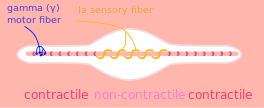Intrafusal muscle fiber
| Intrafusal muscle fiber | |
|---|---|
 A muscle spindle, with γ motor and Ia sensory fibers | |
| Details | |
| Identifiers | |
| Latin | myofibra intrafusalis |
| Code | TH H3.03.00.0.00012 |
Intrafusal muscle fibers are skeletal muscle fibers that serve as specialized sensory organs (proprioceptors) that detect the amount and rate of change in length of a muscle.[1] They constitute the muscle spindle and are innervated by two axons, one sensory and one motor. Intrafusal muscle fibers are walled off from the rest of the muscle by a collagen sheath. This sheath has a spindle or "fusiform" shape, hence the name "intrafusal".
There are two types of intrafusal muscle fibers: nuclear bag and nuclear chain fibers. They bear two types of sensory ending, known as annulospiral and flower-spray endings. Both ends of these fibers contract but the central region only stretches and does not contract.
They are innervated by gamma motor neurons and beta motor neurons. It is by the sensory information from these two intrafusal fiber types that an individual is able to judge the position of their muscle, and the rate at which it is changing.
Intrafusal muscle fibers are not to be confused with extrafusal muscle fibers, which contract, generating skeletal movement and are innervated by alpha motor neurons.
See also
- Alpha motor neuron
- Beta motor neuron
- Extrafusal muscle fiber
- Gamma motor neuron
- Type Ia sensory fiber
- Type II sensory fiber
References
- ↑ Casagrand, Janet (2008) Action and Movement: Spinal Control of Motor Units and Spinal Reflexes. University of Colorado, Boulder.
External links
- Histology at ucsd.edu
- Histology at umdnj.edu
- "Chapter 1: The Muscle Spindle and the Central Nervous System". Neuromuscular Reeducation with Electromyometric Feedback (PDF). Advanced Therapy Institute. Retrieved 30 November 2013.